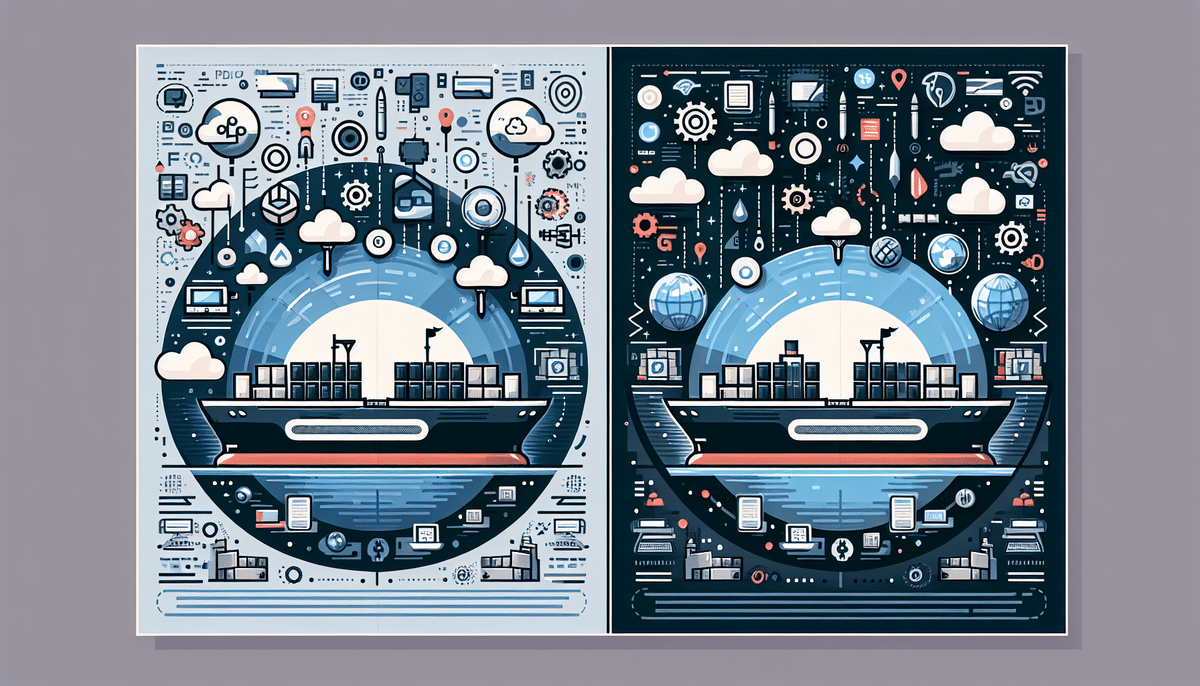ShipMonk vs Fulfillment by Amazon (FBA)
If you're an online business owner, you know how crucial order fulfillment is to your success. Without a reliable and efficient fulfillment process, you risk frustrating your customers with delayed shipments, poor product quality, and inadequate customer support. That's where ShipMonk and Fulfillment by Amazon (FBA) come in – two of the most popular and reputable e-commerce fulfillment solutions available today. In this article, we'll explore the major differences between ShipMonk and FBA to help you make an informed decision about which platform to choose for your business.
An Overview of ShipMonk and FBA
ShipMonk is a full-service fulfillment provider that assists e-commerce businesses with everything from warehousing to shipping to returns management. Founded in 2014, ShipMonk has rapidly grown to become one of the top-rated fulfillment providers in the industry. ShipMonk's services include inventory management, picking and packing, shipping, tracking, and returns processing.
Fulfillment by Amazon (FBA) is a service provided by Amazon that allows you to store your inventory in Amazon's fulfillment centers. Amazon handles picking, packing, shipping, customer service, and returns. FBA is often considered the gold standard for order fulfillment, thanks to Amazon's extensive network of warehouses and logistics expertise.
Understanding the Basics of E-commerce Fulfillment
Before diving into the specifics of ShipMonk and FBA, it's important to understand the fundamentals of e-commerce fulfillment. At its core, e-commerce fulfillment involves storing inventory, preparing orders for shipment, and delivering those orders to the customer. While this may sound straightforward, it can be a complex process requiring careful planning, specialized tools, and logistics expertise.
Key considerations in e-commerce fulfillment include:
- Inventory Management: Tracking available stock and ensuring sufficient inventory to fulfill orders.
- Pick and Pack: Selecting items from inventory, packing them securely, and applying shipping labels.
- Shipping: Arranging for carriers to pick up packages and transport them to their destination.
- Tracking and Returns: Monitoring packages in transit and handling customer returns efficiently.
The Pros and Cons of ShipMonk and FBA for E-commerce Businesses
With an understanding of e-commerce fulfillment basics, let's compare ShipMonk and FBA to see how they stack up against each other. Each platform has its pros and cons, and it's crucial to evaluate them based on your specific business needs.
Pros of ShipMonk
- Handles complex fulfillment needs, such as kitting, subscription boxes, and international shipments.
- Offers transparent pricing with no hidden fees or long-term contracts.
- Provides strong customer support with a dedicated account manager for each client.
Cons of ShipMonk
- Higher startup costs, including fees for onboarding and setting up new accounts.
- Smaller network of warehouses compared to FBA, which can result in longer shipping times for some customers.
- Less established, potentially resulting in lower brand recognition and trust compared to FBA.
Pros of FBA
- Massive network of warehouses and carrier partnerships, leading to faster shipping times and potentially lower shipping costs for some customers.
- Seamless integration with Amazon's e-commerce platform, facilitating easy management of orders and inventory in one place.
- Strong brand recognition and trust, which can enhance customer confidence in your business.
Cons of FBA
- Higher fees, especially for long-term storage and multi-channel fulfillment.
- Less control over the fulfillment process, as FBA handles everything from storage to shipping.
- Strict FBA policies regarding product quality and packaging, which can result in additional fees or restrictions if not closely followed.
Pricing Models: A Comparison of ShipMonk vs FBA
Pricing is a critical factor when choosing between ShipMonk and FBA. Both platforms offer different pricing models tailored to your business needs. Understanding these pricing structures is essential before making a decision.
ShipMonk Pricing
ShipMonk provides a volume-based pricing model, offering lower rates for businesses that ship more orders each month. Pricing typically includes fees for storage, picking and packing, and shipping, tailored to your specific needs.
FBA Pricing
FBA fees are based on a combination of storage fees, pick and pack fees, and shipping fees. Similar to ShipMonk, FBA offers discounts for higher order volumes. A significant consideration with FBA is the long-term storage fees, charged for inventory stored in Amazon's warehouses for more than six months. According to Amazon's [Fulfillment by Amazon Pricing](https://sellercentral.amazon.com/gp/help/external/200141500), understanding these fees is crucial to managing your costs effectively.
Shipping and Delivery Options: How Do ShipMonk and FBA Compare?
When evaluating shipping and delivery options, both ShipMonk and FBA offer a variety of choices to suit your business needs. Here's a comparison of their key shipping and delivery options:
ShipMonk Shipping Options
- Carrier Options: Partners with a variety of carriers, including USPS, FedEx, UPS, and DHL.
- Shipping Speeds: Offers a range of shipping speeds, from economy to express.
- International Shipping: Provides international shipping options and handles customs and duty fees.
FBA Shipping Options
- Carrier Options: Works with several carriers, including UPS, FedEx, and USPS.
- Shipping Speeds: Offers a range of shipping speeds, with free two-day shipping available for Prime members.
- International Shipping: Provides international shipping options, though may not be as extensive as ShipMonk's.
Inventory Management: How Do ShipMonk and FBA Compare?
Effective inventory management is crucial when choosing a fulfillment provider. Both ShipMonk and FBA offer robust inventory management solutions, but there are notable differences between the two.
ShipMonk Inventory Management
ShipMonk's inventory management system allows real-time tracking of stock levels and alerts when inventory is low. It integrates with popular e-commerce platforms like Shopify and WooCommerce, enabling seamless management of inventory across multiple sales channels.
FBA Inventory Management
FBA's inventory management system is also comprehensive, featuring automatic reordering and restocking alerts. However, a limitation of FBA is the less seamless integration with other e-commerce platforms compared to ShipMonk.
Customer Support, Returns, and Refunds: Which is Better – ShipMonk or FBA?
Customer support and returns processing are vital aspects of any fulfillment provider. Let's compare ShipMonk and FBA in these areas.
ShipMonk Customer Support and Returns
ShipMonk is known for its excellent customer support, providing a dedicated account manager for each client. Additionally, ShipMonk offers various returns processing options, including returns management, quality control, and restocking.
FBA Customer Support and Returns
FBA also offers strong customer support, with a team of specialists available to assist with any issues. FBA provides a robust returns management system, including options for processing refunds and replacement orders. According to Amazon's [FBA Customer Support](https://sellercentral.amazon.com/gp/help/external/201817070), their support is designed to handle high volumes efficiently.
Case Studies: Real-world Comparisons of E-commerce Businesses Using ShipMonk vs FBA
Comparing ShipMonk and FBA based on features and pricing is helpful, but real-world examples provide valuable insights. Let's examine a few case studies to see how ShipMonk and FBA have supported business growth.
Case Study 1: Gardenio
Gardenio, an e-commerce business selling garden kits and supplies, initially used FBA for order fulfillment. However, after encountering inventory discrepancies and high fees, Gardenio switched to ShipMonk. This transition improved supply chain efficiency and reduced overhead costs, resulting in higher profits. [Source](https://www.shopify.com/blog/ecommerce-fulfillment)
Case Study 2: Piper Lou Collection
Piper Lou Collection, a humor apparel and gift brand, utilizes both ShipMonk and FBA for fulfillment needs. Using both platforms has allowed Piper Lou Collection to offer faster shipping times and better customer service to their customers. [Source](https://www.forbes.com/sites/forbesbusinesscouncil/2023/03/15/how-multi-channel-fulfillment-boosts-ecommerce-success/)
Which One Should You Choose – ShipMonk or FBA? A Comprehensive Guide to Help You Decide
Having compared ShipMonk and FBA based on features, pricing, and case studies, let's summarize the key factors to consider when choosing between these two platforms.
When to Choose ShipMonk:
- If you have complex fulfillment needs, such as kitting or subscription boxes.
- If you prefer transparent pricing with no long-term contracts.
- If you desire a dedicated account manager and strong customer support.
When to Choose FBA:
- If you want faster shipping times and lower shipping costs, especially for Prime members.
- If you seek seamless integration with Amazon's e-commerce platform.
- If you value strong brand recognition and trust.
Alternatives to ShipMonk and FBA: Other E-commerce Fulfillment Options to Consider
While ShipMonk and FBA are two of the most well-known e-commerce fulfillment providers, there are several other options that may better suit your business needs. Consider the following alternatives:
- ShipBob: A full-service fulfillment provider focusing on fast and affordable shipping.
- Rakuten Super Logistics: Offers flexible inventory management and cost-effective shipping options.
- Red Stag Fulfillment: Specializes in fulfillment for large and heavy items.
Tips for Maximizing the Benefits of Both Platforms: Best Practices for Using ShipMonk and/or FBA Effectively
Regardless of which platform you choose, following best practices can help you maximize the benefits of your fulfillment provider. Here are some tips for using ShipMonk and FBA effectively:
- Invest in Inventory Management Software: Keeping track of inventory levels is crucial to avoid stockouts and missed sales. Utilize tools that help you manage this process efficiently.
- Focus on Customer Service: Providing excellent customer service builds trust and differentiates your business from competitors.
- Stay on Top of Fees and Policies: Both ShipMonk and FBA have various fees and policies that can impact your bottom line. Understand these upfront and stay updated on any changes.
Conclusion and Next Steps – What's Next After Choosing Between ShipMonk vs Fulfillment by Amazon (FBA)
Choosing between ShipMonk and FBA may seem daunting, but by carefully evaluating your needs and considering the factors outlined in this article, you can make an informed decision about which platform is right for your business. Once you've made your choice, it's essential to stay on top of your fulfillment operations and continuously seek ways to optimize and improve your processes for sustained growth and customer satisfaction.






















